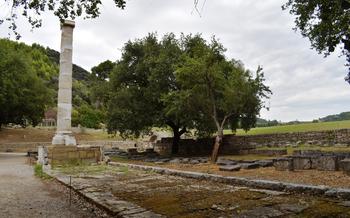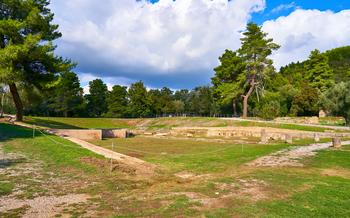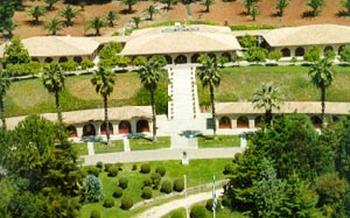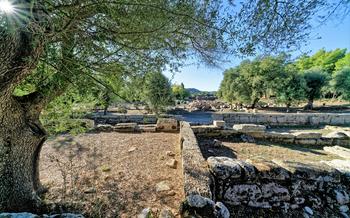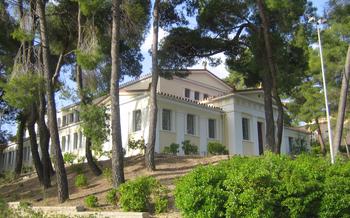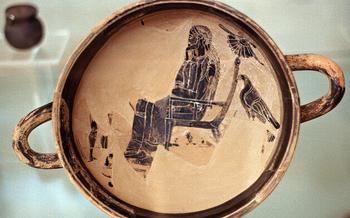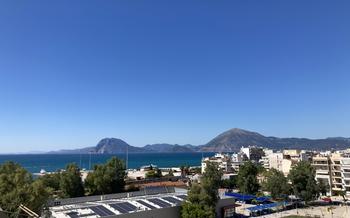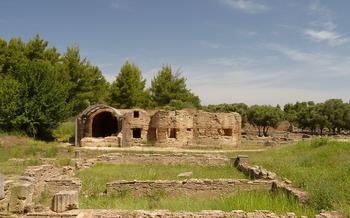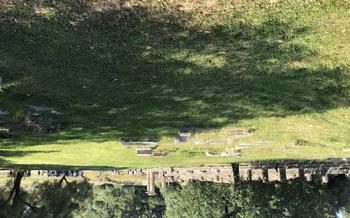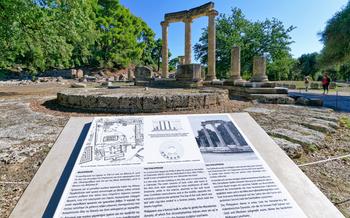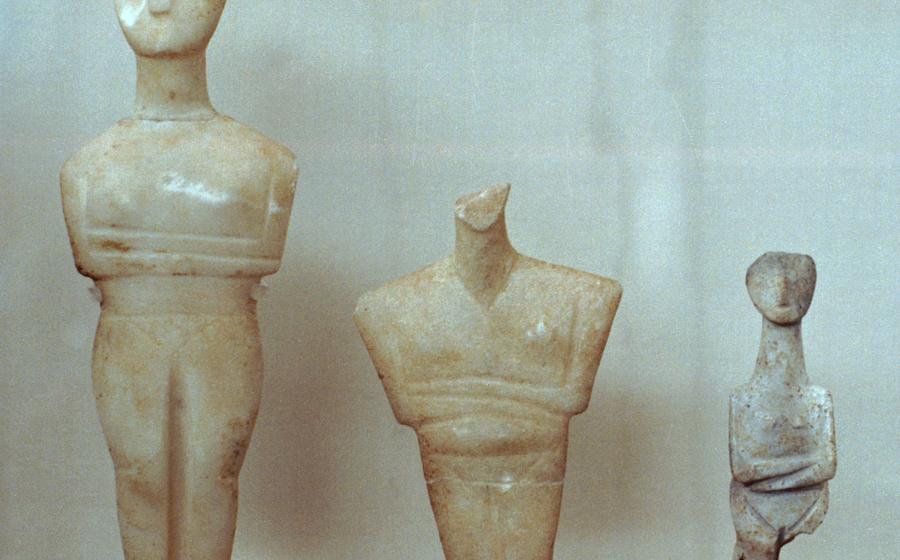
Ancient Elis
- Olympia: A Journey Through History
- The Temple of Zeus: A Masterpiece of Ancient Architecture
- The Stadium: Where Legends Were Made
- Museum of Olympia: A Treasure Trove of Ancient Artifacts
- The Pelopion: Sanctuary of the Legendary King
- The Philippeion: A Monument to Macedonian Power
- The Prytaneion: Center of Civic and Religious Life
- The Bouleuterion: Assembly Place for Civic Affairs
- The Gymnasium: School for Mind and Body
- The Hippodrome: Chariot Racing and Equestrian Events
- Insider Tip: Explore the Surrounding Area
Olympia: A Journey Through History
Olympia, nestled in the picturesque valley of Elis, is a place where history, mythology, and natural beauty intertwine. This ancient city, once the heart of the Olympic Games, holds a profound significance in the annals of Greek civilization. As you step into Olympia, you embark on a journey that transcends time, transporting you back to the era of gods, athletes, and epic contests.
The Olympic Games, originating in the 8th century BC, were more than just athletic competitions; they were a sacred festival honoring Zeus, the king of the gods. Held every four years, the games drew athletes and spectators from far and wide, creating a sense of unity and camaraderie among the Greek city-states. Olympia, as the host of these prestigious games, became a symbol of peace, sportsmanship, and the pursuit of excellence.
Beyond its sporting legacy, Olympia was a thriving religious and cultural center. The site was home to numerous temples, altars, and sanctuaries dedicated to various deities. The most prominent among them was the Temple of Zeus, an architectural marvel that housed the iconic statue of Zeus by Phidias, one of the Seven Wonders of the Ancient World.
The natural beauty of Olympia further enhances its allure. The Kladeos River, meandering through the valley, adds a touch of serenity to the landscape. The surrounding hills, dotted with olive groves and cypress trees, provide a backdrop that seems to have remained unchanged since ancient times. In Olympia, history, nature, and spirituality converge, creating a destination that captivates the imagination and leaves an indelible mark on every visitor.
The Temple of Zeus: A Masterpiece of Ancient Architecture
The Temple of Zeus, a monumental Doric structure, stood as a testament to the architectural prowess of the ancient Greeks. Constructed from local limestone and adorned with marble tiles, it measured an impressive 64 meters in length, 27 meters in width, and 20 meters in height. Its grandeur was further enhanced by the iconic statue of Zeus, crafted from ivory and gold by the renowned sculptor Phidias. Towering over 12 meters, the statue depicted the king of the gods seated on a magnificent throne, exuding an aura of majesty and power.
The temple's exterior was adorned with intricate sculptures and reliefs, showcasing the exceptional artistry of ancient Greek craftsmen. The east pediment depicted the preparations for the chariot race between Pelops and Oenomaus, while the west pediment portrayed the battle between the Centaurs and the Lapiths. The metopes, located above the columns, displayed a variety of mythical scenes, including the labors of Hercules and the exploits of Theseus.
Inside the temple, the atmosphere was one of awe and reverence. The colossal statue of Zeus dominated the interior, its ivory and gold gleaming in the flickering light of oil lamps. The statue's realistic features and intricate details left visitors in awe, reinforcing the belief that it was the work of the gods themselves.
The Temple of Zeus was not just a religious edifice but also a symbol of Greek unity and athleticism. It stood as a testament to the power of the Olympic Games, which brought together athletes from all corners of the Hellenic world to compete in honor of Zeus. The temple's construction and decoration reflected the importance of the games and the values they embodied.
The Stadium: Where Legends Were Made
The ancient stadium of Olympia stands as a testament to the athletic prowess and competitive spirit of the ancient Greeks. Built in the 5th century BC, this awe-inspiring arena was the centerpiece of the Olympic Games, the most prestigious sporting event in the ancient world.
Picture yourself transported back in time, standing among the thousands of spectators who packed the stadium's earthen slopes. The air is thick with anticipation as the athletes, their bodies glistening with olive oil, prepare to compete in a variety of events, including footraces, wrestling, discus, javelin, and long jump.
As the starting gun sounds, a blur of movement fills the stadium. The runners, their powerful legs pumping, strain every sinew to reach the finish line first. The crowd erupts in cheers and jeers, their emotions palpable as they witness the birth of legends.
History whispers the names of these ancient champions—Leonidas of Rhodes, Milo of Croton, Theagenes of Thasos—their feats of strength and agility forever etched in the annals of sporting history. These men were more than just athletes; they were heroes, their victories celebrated throughout the Greek world.
In the spirit of these legendary athletes, modern-day track and field events are still held at the ancient stadium. Imagine the thrill of watching world-class runners, jumpers, and throwers compete on the same hallowed ground where their ancient counterparts once battled for glory.
The experience is both exhilarating and humbling, a reminder of the enduring power of sport to unite people from all walks of life in the pursuit of excellence. Whether you're a seasoned sports fan or simply a curious traveler, a visit to the ancient stadium of Olympia is an unforgettable journey through time, where history, myth, and athleticism intertwine to create an experience that will stay with you long after you leave.
Museum of Olympia: A Treasure Trove of Ancient Artifacts
Enrich your understanding of ancient Greek culture and history at the Museum of Olympia, a treasure trove of artifacts unearthed from the sacred site. Wander through its galleries, marveling at an impressive collection of sculptures, pottery, and other relics that paint a vivid picture of life in ancient Greece. Among the highlights is the renowned Hermes of Praxiteles, a breathtaking marble statue that captures the essence of the messenger god with its graceful poise and intricate detailing. Don't miss the opportunity to admire the exquisite bronzes, including the life-size statue of Zeus, and the delicate ivory and gold ornaments that showcase the exceptional craftsmanship of ancient Greek artisans. Each artifact tells a story, providing a glimpse into the religious beliefs, artistic traditions, and daily life of this remarkable civilization. Take your time exploring the museum's exhibits, letting the ancient treasures transport you back in time and deepen your appreciation for the rich cultural heritage of Greece.
The Pelopion: Sanctuary of the Legendary King
In the heart of Olympia, nestled amidst the ruins of ancient temples and monuments, lies the Pelopion, a sanctuary dedicated to the mythical hero and king, Pelops. According to Greek mythology, Pelops was the son of Tantalus, a king of Lydia, and was exiled from his homeland for killing his half-brother. He arrived in Olympia and competed in a chariot race against King Oenomaus for the hand of his daughter, Hippodamia. Pelops emerged victorious with the help of the sea god Poseidon, who had given him a golden chariot and winged horses.
The Pelopion, a testament to the enduring legacy of Pelops, was constructed in the 6th century BC. Archaeological excavations have revealed the remains of a monumental altar, surrounded by a peribolos wall and a sacred grove of trees. Within the sanctuary, offerings were made to Pelops, seeking his favor and protection. The site also served as a venue for athletic competitions and religious festivals in honor of the legendary king.
Stories and legends abound, intertwining with the history of the Pelopion. It is said that Pelops' tomb was located within the sanctuary, and that his spirit continued to reside there, guiding and protecting the people of Olympia. The site has also been associated with the ancient Olympic Games, with some scholars believing that early athletic contests were held in honor of Pelops before the formalization of the Olympic Games in 776 BC.
Ongoing excavations and research at the Pelopion continue to shed light on the significance of this sacred site. Archaeologists have unearthed numerous artifacts, including pottery, bronze statuettes, and inscriptions, providing valuable insights into the religious practices and rituals associated with the worship of Pelops. The Pelopion stands as a testament to the enduring power of myth and legend, a place where the past and present intertwine, inviting visitors to explore the rich tapestry of ancient Greek history and mythology.
The Philippeion: A Monument to Macedonian Power
In the heart of Olympia, amidst the ruins of ancient temples and stadiums, stands the Philippeion, a magnificent circular monument that pays homage to the power and prestige of the Macedonian dynasty. Built in the 4th century BCE by Philip II, the father of Alexander the Great, the Philippeion served as a symbol of Macedonian dominance over Greece.
Its unique design, featuring a colonnade of Ionic columns encircling a central cella, sets it apart from the other rectangular temples in Olympia. Elaborate sculptures once adorned the pediments and metopes, depicting scenes from Greek mythology and Macedonian history. The most notable sculptures, now housed in the Olympia Museum, include a depiction of Alexander the Great's triumph over the Persian king Darius III at the Battle of Issus.
The Philippeion's construction marked a significant shift in the political landscape of ancient Greece. The Macedonians, once considered outsiders, had now become the dominant power, and the Philippeion served as a lasting testament to their influence. Its grandeur and opulence reflected the wealth and ambition of the Macedonian kings, who sought to surpass their Greek rivals in every way.
As you stand before the Philippeion, let your imagination transport you back to the era of Alexander the Great. Picture the Macedonian phalanx marching in formation, their shields gleaming in the sun. Hear the roar of the crowd as chariots race around the nearby Hippodrome, their riders urging their horses to victory. Feel the power and majesty of the Macedonian Empire, which, for a brief but brilliant moment, held sway over the entire Greek world.
The Prytaneion: Center of Civic and Religious Life
At the heart of ancient Olympia stood the Prytaneion, a monumental building that served as the central hub for civic and religious ceremonies. This sacred structure housed the sacred fire that burned continuously, symbolizing the eternal flame of the Olympic spirit. The Prytaneion was a place of immense importance, where officials conducted civic business, athletes prepared for the Olympic Games, and citizens gathered to celebrate religious festivals.
Excavations have revealed the impressive remains of the Prytaneion, including its grand courtyard, colonnaded halls, and intricate mosaic floors. Archaeologists have uncovered evidence of various rooms and chambers, each dedicated to specific functions. There was a grand dining hall where officials and honored guests feasted, a kitchen where meals were prepared, and storage rooms where provisions were kept.
The sacred fire, tended by priestesses known as Prytaneiai, burned continuously in a central hearth within the Prytaneion. This fire was a symbol of the city's unity and continuity, and its preservation was considered a sacred duty. The Prytaneion also served as a sanctuary for those seeking refuge, as it was believed that the sacred fire offered protection and asylum.
Stories and legends abound about the Prytaneion and its significance in ancient Olympia. It is said that the fire was first brought to Olympia by the mythical hero Prometheus, who stole it from the gods on Mount Olympus. Another legend tells of the Olympic victors who would return to the Prytaneion after their triumphs, where they were honored with feasts and celebrations.
The Prytaneion stands as a testament to the deep religious and civic traditions of ancient Greece. Its ruins offer a glimpse into the daily life and rituals of this ancient city, where the Olympic spirit burned brightly, and the sacred fire symbolized the enduring legacy of Olympia.
The Bouleuterion: Assembly Place for Civic Affairs
The Bouleuterion, or Council House, played a crucial role in the political life of ancient Olympia. Constructed in the 5th century BC, this impressive building served as the assembly place for the Boule, or Council, a body of 600 citizens randomly selected to advise the city's magistrates and decide on important matters of governance.
The Bouleuterion was a large, rectangular structure with a capacity to accommodate all 600 members of the Council. It featured a central courtyard surrounded by a colonnade, with stone benches arranged in a semicircular fashion to allow for comfortable seating. The acoustics were carefully designed to ensure that even those seated at the back could clearly hear the proceedings.
The Council met regularly to discuss and debate various issues related to the city's administration, finances, and religious affairs. Their decisions were significant in shaping the policies and laws that governed Olympia and its surrounding region. The Bouleuterion, therefore, served as a vital institution in the democratic functioning of the ancient city.
In addition to its political role, the Bouleuterion also had a symbolic significance. Its impressive architecture and prominent location reflected the importance of civic participation and collective decision-making in ancient Greek society. It stood as a testament to the democratic ideals that underpinned the functioning of the city-state.
Today, visitors to Olympia can explore the ruins of the Bouleuterion and marvel at its well-preserved architectural features. The building's imposing presence and its historical significance offer a glimpse into the political and administrative processes that shaped the life of this ancient city.
The Gymnasium: School for Mind and Body
The Gymnasium in Olympia served a dual purpose, catering to both physical training and intellectual pursuits. This remarkable institution played a pivotal role in shaping the minds and bodies of young Greek men, laying the foundation for their future contributions to society.
The Gymnasium's architectural design reflected its multifaceted nature. It featured a spacious courtyard surrounded by colonnades, providing a sheltered area for physical activities. Within the courtyard, wrestling pits and exercise areas allowed athletes to hone their skills and develop their strength.
Beyond physical training, the Gymnasium also served as a center for intellectual exploration and philosophical discourse. Classrooms and lecture halls lined the courtyard, where renowned philosophers and scholars imparted their wisdom to eager students. These young men engaged in lively debates, delving into the mysteries of philosophy, mathematics, and the natural world.
The Gymnasium's significance extended beyond its walls, deeply influencing ancient Greek culture. It embodied the ideal of a well-rounded education, emphasizing the harmonious development of both mind and body. This holistic approach to education produced individuals who were not only physically fit but also intellectually sharp and morally upright, capable of making meaningful contributions to their communities.
Imagine yourself transported back in time, sitting among the students in the Gymnasium's lecture halls, listening to the profound teachings of ancient philosophers. Or picture yourself training alongside aspiring athletes, pushing your limits and striving for excellence. The Gymnasium offers a glimpse into the intellectual and physical pursuits that shaped the lives of ancient Greeks, leaving an enduring legacy that continues to inspire us today.
The Hippodrome: Chariot Racing and Equestrian Events
In ancient Greece, the Hippodrome was a vital component of the Olympic Games, serving as the arena for thrilling chariot races and equestrian events. Located just outside the main archaeological site, the Hippodrome's impressive remains evoke the grandeur of these sporting spectacles.
Excavations have revealed the starting gates, the track, and the judges' stand, providing a tangible connection to the athletes who competed here centuries ago. Imagine the roar of the crowd as the chariots thundered down the track, their drivers vying for victory. The Hippodrome's layout allowed spectators to have an unobstructed view of the action, creating an electric atmosphere.
Chariot racing was a particularly dangerous sport, with crashes and injuries common. However, the victors were celebrated as heroes, their names etched in history alongside those of the Olympic footracers and wrestlers. The Hippodrome also hosted equestrian events, showcasing the skills of riders and the beauty of their horses.
Today, visitors can wander through the Hippodrome's ruins, marveling at the sheer size of the track and imagining the excitement that once filled the air. It's a powerful reminder of the diversity and athleticism that were celebrated at the ancient Olympic Games.
Insider Tip: Explore the Surrounding Area
Venture beyond the ancient site of Olympia and discover the captivating natural beauty and cultural treasures that the region has to offer. Stroll along the banks of the tranquil Kladeos River, immersing yourself in the serene atmosphere and lush greenery. Take a leisurely bike ride through the picturesque countryside, passing charming villages and olive groves. For a refreshing dip, head to the nearby beaches or plunge into the crystal-clear waters of the river.
The village of Olympia, just a stone's throw from the archaeological site, offers a glimpse into traditional Greek life. Wander through its narrow cobblestone streets, admire the whitewashed houses adorned with colorful flowers, and savor delicious local cuisine at one of the many tavernas. Don't miss the opportunity to interact with the friendly locals, who are always eager to share stories and insights into their culture.
For those seeking adventure, the surrounding area offers a range of activities to suit every taste. Embark on a thrilling hike through the scenic mountains, taking in breathtaking views of the countryside. Explore the nearby forests, home to a diverse array of flora and fauna. If you're an adrenaline junkie, try your hand at white-water rafting on the Alfios River, a thrilling experience that will surely leave you exhilarated.
When it comes to transportation, Olympia is well-connected by bus and train to major cities like Athens and Patras. Renting a car is also a convenient option, allowing you the freedom to explore the region at your own pace. For accommodation, there are plenty of options to choose from, ranging from budget-friendly hostels to luxurious resorts.
Whether you're a history buff, nature enthusiast, or adventure seeker, the area surrounding Olympia has something to offer everyone. Embrace the opportunity to immerse yourself in the region's rich heritage, stunning landscapes, and warm hospitality. Create unforgettable memories that will last a lifetime.
